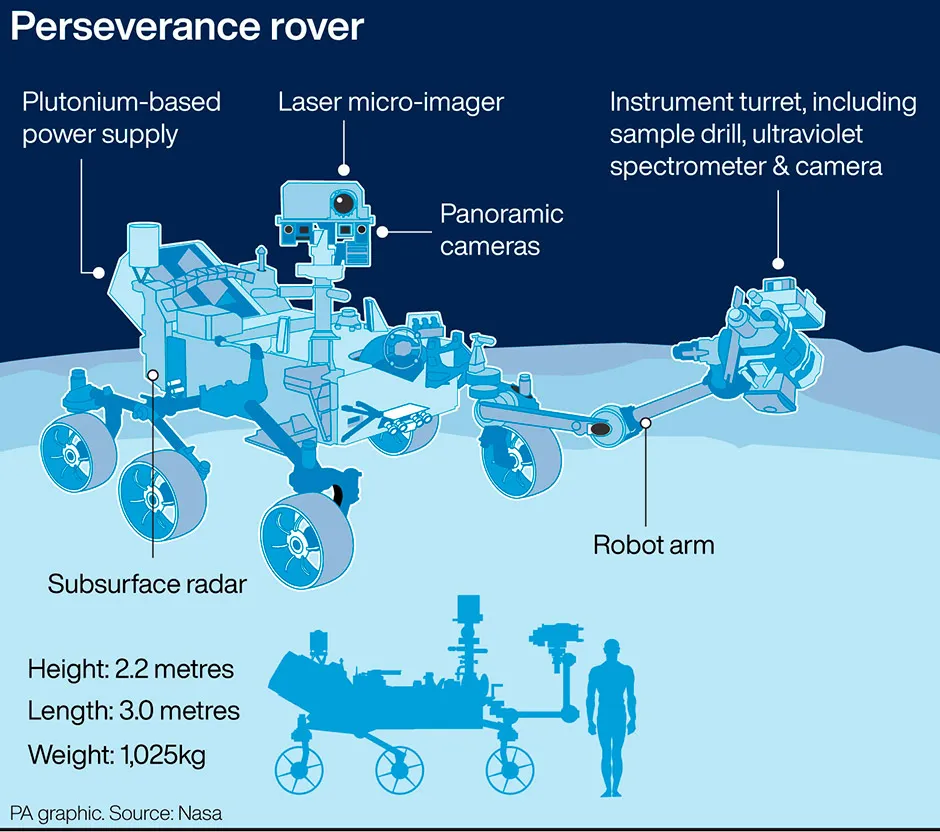NASA has unveiled a first-of-its-kind video captured by the Mars Perseverance rover as it touched down on the Red Planet, and released the first audio recorded on the surface of Mars.
The minute-long footage is of the rover recording itself landing on 18 February.It shows the parachute deployed for landing, and the Martian surface below, with the rover getting slowly closer to landing, and dust on the surface being rapidly disturbed before it finally touches down.
“These videos and these images are the stuff of our dreams, it’s been what we’ve been dreaming about for years," said Allen Chen, of NASA’s Jet Propulsion Laboratory (JPL).
NASA described the footage as “amazing”, adding that Perseverance is healthy and continuing with activities as planned for the first few days on Mars’s surface.
The agency also released audio of the first sounds recorded from the surface of Mars.A microphone on the rover captured a gust of wind on the Red Planet, and the sounds of Perseverance itself.
“This is the first time we’ve been able to actually capture an event like the landing of a spacecraft on Mars," said JPL director Dr Michael Watkins, speaking at a press conference.
“These are pretty cool videos, and we will learn something by looking at the performance of the vehicle in these videos, but a lot of it is also to bring you along on our journey, our touchdown to Mars and of course our surface mission as well. And these are really amazing videos.”
Playing what he said were the “first sounds being recorded from the surface of Mars”, Dave Gruel, Perseverance EDL camera lead, said: “We can sit here now and actually tell you that we have recorded sound from the surface of Mars.”
NASA also released more new images the rover took on the Martian surface.
Read more about the Perseverance mission:
- NASA’s Perseverance sends its first pictures back from Mars
- Ingenuity: How the Mars helicopter will fly on another planet
Matt Wallace, Perseverance deputy project manager with JPL, said he was inspired to find a way to attach a camera to capture landing after his daughter attached a store-bought camera to herself to record her doing a backflip.
He added: “This was not a camera specifically designed for use on Mars. You can purchase the same camera off the internet for whatever applications you might have for it.
“This is most certainly… as far as I know, this is the first time we’ve been able to see ourselves see our spacecraft land on another planet. As far as sound, to the best of my knowledge, this is the first planetary sound that’s been recorded.”
Past NASA missions have recorded timelapse videos, and the InSight lander measured seismic signals that were acoustically driven and then rendered as audio.
After the rover, which blasted off from Earth last July, entered the Martian atmosphere there were “seven minutes of terror” as it made its way to the surface.
It took more than 11 minutes for news of the safe landing to reach Earth, arriving at just before 9pm GMT on Thursday 18 February.
The rover – a scientific laboratory the size of a car – is on a mission to search for signs of ancient life and explore and collect samples for future return to Earth from diverse environments on Mars.
Perseverance will spend the coming years scouring for signs of ancient microbial life in a mission that will bring back samples to Earth and prepare the way for future human visitors.

Scientists know that 3.5 billion years ago the Jezero crater was the site of a large lake, complete with its own delta. They believe that while the water may be long gone, somewhere within the crater, or maybe along its 610-metre-tall (2,000-ft) rim, evidence that life once existed there could be waiting.
Perseverance will gather rock and soil samples using its drill and will store sample cores in tubes on the Martian surface ready for a return mission to bring around 30 samples to Earth in the early 2030s.
It will also trial technologies to help astronauts make future expeditions to Mars. These include testing a method for producing oxygen from the atmosphere, identifying other resources such as subsurface water, and improving landing techniques.They also involve characterising weather and other environmental conditions that could affect future astronauts living and working on Mars.